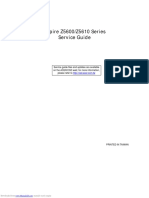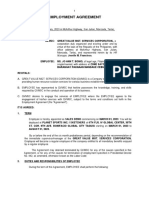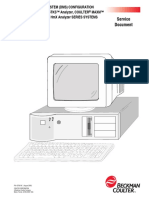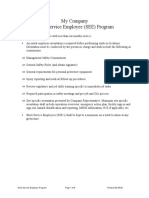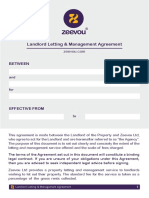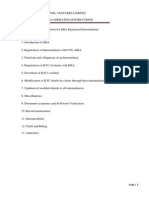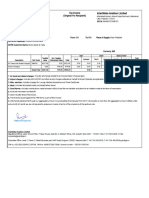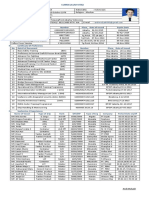Vendor Code of Conduct and EOHS Requirements 2 PDF
Vendor Code of Conduct and EOHS Requirements 2 PDF
Uploaded by
Javeed ShaikhCopyright:
Available Formats
Vendor Code of Conduct and EOHS Requirements 2 PDF
Vendor Code of Conduct and EOHS Requirements 2 PDF
Uploaded by
Javeed ShaikhOriginal Title
Copyright
Available Formats
Share this document
Did you find this document useful?
Is this content inappropriate?
Copyright:
Available Formats
Vendor Code of Conduct and EOHS Requirements 2 PDF
Vendor Code of Conduct and EOHS Requirements 2 PDF
Uploaded by
Javeed ShaikhCopyright:
Available Formats
EMERALD JEWEL INDUSTRY INDIA LIMITED
Internal use only
EMERALD JEWEL INDUSTRY INDIA LIMITED VENDOR CODE OF CONDUCT &
EHS REQUIREMENTS
Document Confidentiality Statement:
The information in this document is confidential to the person to whom it is addressed and should not be disclosed to any
other person. It may not be reproduced in whole, or in part, nor may any of the information contained therein be disclosed
without the prior consent of the directors of Emerald Jewel Industry India Ltd. A recipient may not solicit, directly or
indirectly (whether through an agent or otherwise) the participation of another institution or person without the prior
approval of the directors of the Company.
Any form of reproduction, dissemination, copying, disclosure, modification, distribution and or publication of this
material is strictly prohibited.
Doc. No: E/WD/EOHS/023 Rev Status: 01 Date: 11/07/2022 Page 1 of 16
EMERALD JEWEL INDUSTRY INDIA LIMITED
Internal use only
Contents
1. PURPOSE .................................................................................................................................................... 3
2. SCOPE......................................................................................................................................................... 3
3. VENDOR REQUIREMENTS: ......................................................................................................................... 3
3.1 General: ..................................................................................................................................................... 3
3.2 MSME declaration:..................................................................................................................................... 3
3.3 Deemed acceptance:.................................................................................................................................. 4
3.4 Integrity and Compliance: .......................................................................................................................... 4
3.5 Disputes and Jurisdiction ........................................................................................................................... 5
3.6 Legally binding clauses in the contract are: ............................................................................................... 5
3.7 Escalation in case of non-compliance: ....................................................................................................... 6
3.8 General Safety Rules: ................................................................................................................................. 6
3.9 Statutory Requirements:............................................................................................................................ 8
3.10 Work Permit System: ................................................................................................................................. 9
3.11 Personal Protective Equipment’s (PPEs): ................................................................................................. 10
3.12 Inspection of Tools and Tackles: .............................................................................................................. 10
3.13 Safety Training to Contract Employees: ................................................................................................... 10
3.14 Safety in Work Area & House Keeping:.................................................................................................... 11
3.15 Safety in the use of Equipment & Machinery: ......................................................................................... 11
3.16 Emergency Contact Information: ............................................................................................................. 15
3.17 Vendor Acknowledgement ...................................................................................................................... 16
Doc. No: E/WD/EOHS/023 Rev Status: 01 Date: 11/07/2022 Page 2 of 16
EMERALD JEWEL INDUSTRY INDIA LIMITED
Internal use only
1. PURPOSE
This document is to ensure the legal, Environment & Safety Requirements to be followed by the Vendor
or Contractors doing business or working or get in touch with Emerald Jewel Industry India Limited.
2. SCOPE
Scope is applicable to all vendors or contractors irrespective of work nature.
3. VENDOR REQUIREMENTS:
3.1 General:
The contractor will comply with all laws and regulations applicable to its business, as well as the
standards of its industry, including those about the manufacture, pricing, sale, distribution, labelling,
transport, import, and export of goods and services. Without limiting this requirement, Contractor will
not:
(a) Violate, misappropriate, or infringe upon the intellectual property rights of any person or entity
of EJIIL or
(b) Engage in any activities which would violate any applicable laws and regulations relating to
o Bribery, corruption, or illegal payments
o Unfair competition or unfair and deceptive trade practices
o The environment
o Health and safety
o International trade, including exports and imports
o Data privacy and security
o Money laundering
o Labour and employment
o Anti-slavery and human trafficking laws, statutes, regulations, and codes
o Contracting with governmental entities
3.2 MSME declaration:
Micro, Small, Medium Enterprises (MSME) status should be disclosed by vendor / customer with valid
certificate proof to EJIIL.
Doc. No: E/WD/EOHS/023 Rev Status: 01 Date: 11/07/2022 Page 3 of 16
EMERALD JEWEL INDUSTRY INDIA LIMITED
Internal use only
3.3 Deemed acceptance:
Every PO should be returned with seal and sign to EJIIL within 3 working days from the date of receipt
otherwise it will be considered as deemed acceptance and all terms and conditions will commence
automatically.
3.4 Integrity and Compliance:
The contractor must be committed to the highest standards of integrity in conducting its business.
Specifically:
a) Corruption, Extortion, or Embezzlement; Improper Advantage. The contractor will not engage in
corruption, extortion, or embezzlement in any form, offer or accept bribes or employ any other
means to obtain an undue or improper advantage.
b) The contractor must comply with all applicable anti-corruption laws and regulations of the
countries in which it operates and the Government of India & Tamil Nādu.
c) Additionally, the Contractor must not bribe or provide kickbacks or any other improper payments
or improper gifts to any employee or representative of EJIIL. The contractor must immediately
report to EJIIL any circumstance where any employee or representative of EJIIL has made any such
improper request or demand of the contractor.
d) Accounting Records. The contractor’s accounting records must (1) be kept and presented
according to the laws of each applicable jurisdiction, (2) in reasonable detail, accurately and fairly
reflect transactions, assets, liabilities, revenues, and expenses, and (3) not contain any false or
misleading entries.
e) Conflicts of Interest. The contractor must immediately report to EJIIL any "conflict of interest" of
which it becomes aware. A “conflict of interest” is any circumstance, transaction, or relationship
directly or indirectly involving the Contractor in which the private interest of any employee of EJIIL
improperly interferes, or even appears to improperly interfere, with the interests of EJIIL.
f) Reporting Violations, Non-Retaliation. The contractor is expected to have a policy prohibiting
unlawful and inappropriate conduct that provides employees, and other representatives of the
contractor, a way to raise concerns and a process for investigating and resolving incidents.
Doc. No: E/WD/EOHS/023 Rev Status: 01 Date: 11/07/2022 Page 4 of 16
EMERALD JEWEL INDUSTRY INDIA LIMITED
Internal use only
g) The Contractor must not tolerate retaliation against any employee who makes a good faith report
of abuse, intimidation, discrimination, harassment, or any violation of law or this Code, or who assists
in the investigation of any report.
h) All information acquired by contractor relating to the EJIIL’s business will be as confidential and
Contractor will not make any use or disclosure of it. The Contractor will also keep confidential the
terms of the Contract and all information it obtains concerning contract business. The confidentiality
obligations shall survive termination of the Contract.
i) Contractor will be liable to the EJIIL for any loss of or damage to property caused by the contractor
work and their employee, Debit will be made to the damages or property loss on the settlement.
j) Conflict free Origin of raw materials:
The raw materials supplied by the vendor should be conflict free, as per the corresponding National laws.
Diamond Suppliers are expected to comply UN resolutions, Corresponding national law’s and WDC
guidelines.
Each diamond invoices should carry below mentioned declarations,
• The diamonds herein invoiced have been purchased from legitimate sources not involved in the
funding of conflict, in compliance with United Nations Resolutions and corresponding national laws.
The seller hereby guarantees that these diamonds are conflict free and confirms adherence to the
WDC SOW Guidelines.
• The diamonds herein invoiced are exclusively of natural origin and untreated based on personal
knowledge and/or written guarantees provided by the supplier of these diamonds. The acceptance of
Goods herein in Invoice will be as per the WFDB Guidelines.
3.5 Disputes and Jurisdiction
a) Any disputes by the contractor shall be subject exclusively to the Coimbatore jurisdiction
b) Neither the EJIIL/ Contractor shall take nor adopt any legal proceedings to enforce any claim against
the other relating to this order to arising therefrom in any Court other than the Court of Competent
jurisdiction located within the Coimbatore.
3.6 Legally binding clauses in the contract are:
a) Accountability for contractor companies and their employees in case of non-usage of Personal
Protective Equipment’s (PPE’s), not following Safety instructions, improper disposal of wastes, and any
such violations.
b) Contractor employees shall possess applicable certificates, licenses, and Group or individual
insurance.
Doc. No: E/WD/EOHS/023 Rev Status: 01 Date: 11/07/2022 Page 5 of 16
EMERALD JEWEL INDUSTRY INDIA LIMITED
Internal use only
c) Equipment like a ladder, welding machine, cutting machine, drilling machine, scaffolding, gas
cylinders & Gas cutting equipment’s, Centering, Electrical cables & Switch boxes, and other tools must
comply with the safety standards.
d) The vehicles plying inside Emerald premises shall comply with the requirements of “Central Motor
vehicles Rules”.
e) In case of any accident happened to Contract Employees inside the Emerald premises, the
accountability lies with the contractor.
3.7 Escalation in case of non-compliance:
Escalation in case of non-compliance/violations of EHS requirements by the Contract c ompanies,
contractor employees, and subcontractors:
a) In case of the first instance of non-compliance during the activities, a warning is given to both the
contractor employee and his company.
b) In the case of the second instance, the penalty is imposed on the contractor employee and his
company.
i) Safety notice along with the details of non-compliance and penalty is issued to the contractors
after the second instance.
ii) Fine is decided based upon the degree of non-compliance and damage did.
c) In case of repetition of non-compliance for the third time the contract company can be
blacklisted, and the contract can be terminated.
3.8 General Safety Rules:
a) Smoking and Tobacco, Pan, Gutka usage within the Emerald premises is prohibited. Nobody shall
bring a matchbox or lighter inside the Emerald premises.
b) While working in a confined space, Work at height Cell phones usage, and listening to music are
prohibited.
c) The engine should be in off condition and the key should be carried along with the driver when the
vehicle is parked and should ensure to apply hand brake and keep Wheel stopper.
d) Ensure availability of applicable updated vehicle documents like as (RC, Vehicle insurance, driving
license, Pollution certificate, Tanker fitness certificate, Hazardous goods handling license, TREM
Card, MSDS, Rubber Lining Tanker Test Certificate, Vehicle fitness Certificate, lifting equipment &
tackles competent certificate and Operator Eye Fitness certificate).
Doc. No: E/WD/EOHS/023 Rev Status: 01 Date: 11/07/2022 Page 6 of 16
EMERALD JEWEL INDUSTRY INDIA LIMITED
Internal use only
e) Anti-fall guard/safety net/fall protection should be used as a protection measure when the person
is working at height.
f) Cranes approved by safety officer should be used and documents like as (RC, Vehicle insurance,
driving license (Special license), Pollution certificate, Vehicle fitness Certificate, lifting, equipment
& tackles competent certificate, and Operator Eye Fitness certificate to be kept ready for
verification at any time.
g) The contractor’s employees should not report to work in an intoxicated condition. Drinking
alcohol within Emerald premises is prohibited.
h) Contractors’ employees should take the food only at designated places.
i) The contractor shall engage competent supervisor/s to oversee the safety of the job and workers.
The supervisor is to be trained/ informed about the hazards which may arise in the work to be
carried out; the supervisor shall be present at the worksite. In his absence, the alternate person
shall be nominated who is also trained in safety related to the job.
j) The contractor shall employ competent persons to carry out the work assigned. The contractor
shall be aware of the hazards associated with the job.
k) The contractor/contract supervisor must report to the project in-charge/concerned head of
department (HOD) in emerald, daily before starting work, to
a. Establish the scope of the day’s work
b. To obtain the necessary work permits.
l) Any work beyond normal working hours (6:00 PM onwards) needs permission from the concerned
HOD. Extension for working hours shall be planned well in advance. The concerned department
will not grant this extension if it is not safe to work beyond the normal working hours.
m) Always walk; never run at work site unless specifically instructed during an emergency.
Contractor/contract employees shall use regular aisles & gangways without making any shortcuts.
They should confine themselves to the designated workplace.
n) In case of emergency, contractor/contract employees should assemble at the nearest safe
assembly point and wait for further instructions from the safety officer.
o) Contractor/contract employee shall not indulge in horseplay or make any loud and unusual noises
as it may distract the attention of others.
p) Contractor/contract employees shall not use compressed air for cleaning their clothes or body.
q) Contractor/contract employee shall not interfere with machinery, guards, safety devices, or
interlocks.
Doc. No: E/WD/EOHS/023 Rev Status: 01 Date: 11/07/2022 Page 7 of 16
EMERALD JEWEL INDUSTRY INDIA LIMITED
Internal use only
r) All tools and tackles shall be in safe working condition and the tampered tools/equipment shall NOT
be used.
s) The contractor shall ensure required calibration/test certificates of the instruments/
equipment’s/ lifting tackle and tools used.
t) Automobile used for transportation of employees/materials/equipment’s/wastewater/freshwater etc. shall
have all the statutory permissions and shall be in safe working condition.
u) Good housekeeping shall be maintained at the site.
v) In case of any unsafe conditions prevailing at the work area or unsafe acts by certain individuals, the
same must be brought to the notice of In-charge.
w) It is the responsibility of the contractor/ contract supervisor to conduct the daily toolbox talk for
their employees highlighting safety requirements for that day’s job with an attendance sheet.
x) As a means of creating awareness, posters on good and bad practices for different high-risk
activities shall be displayed at prominent locations in the work area wherever possible.
y) In case of high-risk work, a method statement needs to be prepared to detail the steps that will be
adopted for performing the activity by the contractor supervisor and the same to be approved by
Safety Officer.
z) Chemicals required to perform the job should have a material safety data sheet. This should be
supplied to the Emerald contract coordinator in advance to perform the job. The safety risk related
to the said chemicals should be assessed and controls should be established before the start of the
work. Banned chemicals as per the Factory rules/act and expired chemicals should not be
used/brought to the plant.
3.9 Statutory Requirements:
a) Without prejudice to the generality of what has been stated above, the contractor shall comply
with the statutory requirement of various acts such as,
Factories Act and Tamil Nadu factories Rules.
The Environment Protection Act.
Building and other construction workers act.
Gas cylinder Rules.
Petroleum Act.
Indian Electricity Act.
Indian Boilers Act.
Doc. No: E/WD/EOHS/023 Rev Status: 01 Date: 11/07/2022 Page 8 of 16
EMERALD JEWEL INDUSTRY INDIA LIMITED
Internal use only
Static Mobile and Pressure Vessel Rules.
Central Electricity Authority (CEA) regulation.
State rules for lifts, escalators, and passenger conveyors.
Note: With latest revision or amendment.
b) The contractor shall comply with statutory requirements like labor license, ESI & PF Acts. The
contractor shall hand over the copies of the licenses/documents to the HRD / concerned site in
charge before starting the job.
3.10 Work Permit System:
a) The contractor must follow and adhere to the work permit system of Emerald.
b) The work permit must be obtained from the concerned authority for the following works:
I. Hot work (welding, open burning of bitumen, grinding, Cutting).
II. Confined space entry.
III. Working at heights/ Fragile roofs. Working on the lift, Scaffolding (Above 1.8 meters height
considered as a Height work).
IV. Earth excavation.
V. Lifting Work Permit. (Machine & Material Shifting).
VI. Temporary Electrical connection/Electrical jobs.
VII. Work at high-risk areas (high-risk areas include fuel yards, licensed premises, chemical
stores, processes like heat treatment, and surface treatment operations).
VIII. Any other work may be required within Emerald premises.
c) Safety clearance must be obtained for work related to
I. Opening of pipeline joints.
II. Erection, dismantling, and movement of heavy equipment.
III. Electrical-related work.
IV. Hazardous chemical handling and storage.
V. Flammable and toxic gas and liquid items. (Handling and storage).
VI. Earth excavation.
VII. Confined space Entry.
VIII. Height Work.
IX. Hot work.
X. All shifting and lifting Activities.
d) Display of work permit at the place of work is mandatory.
Doc. No: E/WD/EOHS/023 Rev Status: 01 Date: 11/07/2022 Page 9 of 16
EMERALD JEWEL INDUSTRY INDIA LIMITED
Internal use only
3.11 Personal Protective Equipment’s (PPEs):
a) The contractor shall provide the necessary Personal Protective Equipment (confirming to IS
standards) to his workforce. The use of the following PPEs is considered as an essential and
mandatory requirement:
Helmets with chin strap for all workforces.
Safety shoes or half gumboot with steel or fiber toe (Based on work)
Safety belts with double lane yard for working at a height equal to or more than 1.8 m.
Safety Shoe, Leather Gloves, Leather Apron, Safety goggles or Face shield, Nose mask &
earplugs for gas cutting/grinding activities.
Safety shoes, Safety goggles, and earplugs for chipping activity.
Safety Shoe, Leather Gloves, Leather Apron, Safety goggles or Face shield and nose mask for
welding activity.
Safety shoe, Safety Belt, and Safety Helmet for Height work activity.
Gumboot, Hand gloves, Apron, Safety Goggles, Filter Mask, Fireproof light, Ladder, for
Confined space work activity.
b) Other job-specific PPEs including respirators shall be provided by the contractor wherever
required. However, advice can be obtained from the concerned/Safety department for choosing
the correct PPE.
3.12 Inspection of Tools and Tackles:
All the tools and tackles should be approved by a competent person. The test certificates from
competent authorities for tools like chain pulley block, Belt, Hydraulic Pallet Trucks, Power Tools,
Wire Ropes, D shackles, cranes, Forklift, etc. to be produced. Entry of tools and tackles will be
allowed only after inspection of the same by the safety officer. Defective tool/tackle is not
allowed inside the factory premises.
3.13 Safety Training to Contract Employees:
The contractor shall ensure his entire workforce engaged had undergone safety as well as job-
specific training before deploying them. If any specific training is required for carrying out the
assigned job safely, he shall inform in writing the concerned HOD in Emerald.
Doc. No: E/WD/EOHS/023 Rev Status: 01 Date: 11/07/2022 Page 10 of 16
EMERALD JEWEL INDUSTRY INDIA LIMITED
Internal use only
3.14 Safety in Work Area & House Keeping:
The contractor shall keep the work area clean and remove all scraps and surplus material
generated during the work and after it to be disposed of properly as per the Emerald waste
management systems.
3.15 Safety in the use of Equipment & Machinery:
3.15.1 Scaffolds:
• A scaffold should be firm enough to bear the load of workers and materials. Normally scaffolds
are erected in such a way that they can withstand at least four times the anticipated working
load.
• Inspect the scaffolding thoroughly before allowing the workers on it.
• Provide a safe and convenient means to gain access to the working platform.
• Keep the platform free from any unnecessary obstruction, rubbish, and projected nails.
• Provide boards of at least 150 mm and guardrails at 450 mm & 900 mm on all working platforms
and cross benching, Access ladder, Proper coupler, locking pin and Proper Base Plate are must for
scaffold activity.
• Competent certificate required for scaffolding work.
• Never use platforms less than 30 mm thick. (Wooden scaffolding not allowed inside factory
premises area).
• Before use, the concerned safety supervisor must inspect the scaffolds. Those which are safe to
use should have green tags and those under erection or unsafe for use should have red tags.
3.15.2 Lifting tackles:
• The lifting machines, chain pulley blocks, etc. must be tested by the competent authority and valid
test certificates should be submitted to the project site in-charge.
• Ensure that chain pulley block with locking lever (catch lever) are used.
• The safe working load (SWL) should be clearly marked on each of the above items. In no case, this
rated capacity should be exceeded.
• Do not use a chain pulley block for pulling objects horizontally.
• Barricade the area where lifting activity is taking place and provide a caution board. No person
should stand within a barricaded area.
• Never work or move below the suspended loads.
• During the Lifting activity person must wear Safety shoes, Reflective Jacket, and safety Helmet.
Doc. No: E/WD/EOHS/023 Rev Status: 01 Date: 11/07/2022 Page 11 of 16
EMERALD JEWEL INDUSTRY INDIA LIMITED
Internal use only
3.15.3 Welding:
• Use only the welding equipment conforming to standards.
• Welding machines shall be in good condition and are provided with local isolation switch for
emergency isolation.
• System should be such that electrical shock is prevented. Insulation of electrode holders and
welding cables should be checked daily till the completion of work.
• Barricade the required area and provide a display board.
• Ensure that the area, in which welding sparks are likely to travel, is free from all possible
flammable materials. Keep the cylinders away at safe place.
• Provide face shield, apron, nose mask, leather hand gloves and Safety Shoe to the welder.
• Grind all the burrs after the completion of welding/cutting jobs to make the corners round,
smooth & safe. Ensure that no protruded pieces are left around the site.
• Once Welding work is completed, the fire watcher should monitor the work area for 15 min to
ensure there are no fire hazards in the area.
• After Welding, used welding rods to be stored in a sand bucket or water bucket.
• Only qualified welders are allowed to carry welding activities.
• The supervisor/ Firewatcher needs to monitor the workplace area when welding process is
carried.
• Bare wires, damaged plug Top & Damaged switch boxes are not allowed in emerald factory
premises.
• When Tig welding activity, Gas cylinder to be stored properly in trolly with Locking System.
3.15.4 Gas cutting equipment:
• Use torches, rubber-tubing, etc. As per color code of tubes and confirming to standards.
• Use cylinders (Oxygen, acetylene, LPG) approved in writing by the Chief Controller. Submit copies
of the test certificates/supplier’s authorization to the project in- charge/concerned HOD.
• Standard color codes for the cylinders must be followed. (Oxygen: Black; Acetylene: Maroon)
• The cylinder in use to be mounted on a trolley or tie cylinder with the chain to avoid toppling.
• Provide safety shoes, apron, goggles, or face shield & hand gloves to cutters and helpers.
• Make sure that the rubber tubing is so laid that sharp edges heavy objects and hot surfaces do
not abuse it.
• Gas cutting rubber tube ends should be fixed with the clamps.
Doc. No: E/WD/EOHS/023 Rev Status: 01 Date: 11/07/2022 Page 12 of 16
EMERALD JEWEL INDUSTRY INDIA LIMITED
Internal use only
• Test the valves and joints in tube for leaks by using soap solution daily before the
commencement of work. All leaks shall be rectified before lighting the torch.
• Use proper hose connectors while repairing leaks. Avoid binding with wire or tape.
• Keep nozzle of gas cutting torch clean and free from defects to avoid distortion of flame and
backfiring. Provide a flash-back arrestor in both ends to avoid backfires.
• Unused and empty cylinders must be fitted with a neck cap.
• Used and unused cylinders need to be store separately and properly locked by chain.
• Pressure gauges used in gas cutting equipment to be fixed properly and must be calibrated.
3.15.5 Electrical Safety
• Use portable grinders, drilling machines, cutting machines, Welding machines, Power tools, etc.
confirming to BIS standards.
• Never overload cables beyond the rated capacity. This is one of the common causes of fire.
• Provide the rubber gloves to electricians based on as per rated capacity, Rubber gloves shall be
tested & approved by a competent agency.
• Before commencing repair or maintenance work on any machine, switch off the main supply/
remove fuse, display caution tags on machines and switchboards. Follow the standard lockout,
tag out (LOTO) procedure.
• All equipment should have proper earthing arrangements.
• Do not insert bare wires in the socket for energizing any equipment. Use only plug tops for all the
electrical equipment.
• All-electric bulbs to have a protective wire mesh guard.
• While laying cables, ensure that cables are so laid that they do not obstruct the smooth
movement of men and machinery.
• Make sure that all cables are protected against abuses and possible damage and ensure rating of
ELCB & MCB is fixed at equipment as per activity requirement.
• Junction/extension boxes should be used, and Open connections are not permitted.
• Approved flameproof fittings shall be used in flameproof areas.
• Arrange for sufficient lighting in-case, work extension is required beyond normal working
hours, and get necessary approvals for the same in safety.
• Rubber mats should be provided near/below the electrical Panels.
Doc. No: E/WD/EOHS/023 Rev Status: 01 Date: 11/07/2022 Page 13 of 16
EMERALD JEWEL INDUSTRY INDIA LIMITED
Internal use only
• Check underground cables, gas lines, water lines, Acid pipelines, etc. before starting excavation
jobs. if anything is observed, Get clearance from the concerned department.
3.15.6 Machine Guarding
• All the rotating machinery/parts should be protected with proper guards.
• Necessary safety interlocks should be in place wherever required.
• Hand grinding machines shall possess proper guard on the grinding wheel.
• Follow Log Out & Tag Out (LOTO) procedure when starting maintenance activity for pressurized
machines and other equipment, to cut off the power supply and all pressurized equipment
pressure needs to drain pressure before starting the work.
3.15.7 Floor Openings
• Ensure that the floor, slab, duct, and equipment openings are properly covered with MS plates or
gratings. Barricade the area suitably with Reflector Tapes.
• As for as possible avoid the use of wooden planks for covering the openings. MS plates are
preferred.
• Take special precautions for openings provided for AC ducts which are of smaller sizes and many
times adjacent to walls where the movement of people is more likely.
3.15.8 Gas Cylinders
• All gas cylinders must have test certificates. Copy should be given to the site in charge. A
standard color code must be followed.
• Use proper trolleys to transfer compressed gas cylinders. Do not roll the cylinders.
• Cylinders shall be properly supported by chains/clamps.
• All cylinders shall have valve caps.
• Keep all gas cylinders away from the job in an upright position at a designated place.
• Do not throw the cylinders from the truck on the tire while unloading. Use cradles or unload
cylinders on raised platforms.
• Do not expose cylinders to heat or direct sunlight.
• Proper labelling should be done to identify empty cylinders.
• Cylinder valve wrench to be kept at a proper place.
• Do not apply oil or grease on cylinder valves and fittings.
Doc. No: E/WD/EOHS/023 Rev Status: 01 Date: 11/07/2022 Page 14 of 16
EMERALD JEWEL INDUSTRY INDIA LIMITED
Internal use only
3.15.9 Movement of Equipment and Machinery
• Before starting the activity, plan properly by examining the route, taking measurements, if needed,
to ensure that sufficient clearances are available.
• While planning the route, look for overhead cables, Drainages, pipelines, guide ropes, and other
protruding objects.
• Use a properly rated trolley to move the equipment/machinery.
• Ensure no damage to the walls or other surrounding machinery during movement. Make clear
communication system to follow all the fellow contract men, to avoid misunderstanding.
• If you are moving smaller items like pipelines etc. ensure that these items are properly secured
and tied.
• Accidents/incident / Near Miss or dangerous occurrences to be immediately communicated to
concerned HOD and Safety.
• Know the location of the First Aid Centre before starting the work. This will reduce the time
delays, in-case of any emergencies.
• For all accidents, incidents, and near misses, root cause analysis must be carried out within 24
hours of the occurrence of an incident. The lesson learns to be shared with HOD’s / Safety and
the employees. The required corrective and preventive actions should be implemented
immediately.
3.16 Emergency Contact Information:
In case of Emergency, Contact the Security and Safety department as per the guidelines
provided in the work permit system.
∞∞∞∞∞∞
Doc. No: E/WD/EOHS/023 Rev Status: 01 Date: 11/07/2022 Page 15 of 16
EMERALD JEWEL INDUSTRY INDIA LIMITED
Internal use only
3.17 Vendor Acknowledgement
I certify that my company has received, read, and understood and will abide by Emerald
Jewel Industry India Limited’s Vendor Code of Conduct and EHS requirements.
Company Name and full address
Authorized person name
Designation
Contact number and E-mail ID
Signature and date
Company seal
Doc. No: E/WD/EOHS/023 Rev Status: 01 Date: 11/07/2022 Page 16 of 16
You might also like
- Supplier Code of Conduct-EXPO 2020Document9 pagesSupplier Code of Conduct-EXPO 2020AbdulSalamKattikaraNo ratings yet
- Vitz ManualDocument8 pagesVitz Manualrazafarhan100% (4)
- 820 2565 PDFDocument46 pages820 2565 PDFAlexander Eremin0% (1)
- International Expansion of Astrazeneca in Kenya (Name of Student) (Submission Date)Document13 pagesInternational Expansion of Astrazeneca in Kenya (Name of Student) (Submission Date)Sami Ur RehmanNo ratings yet
- G6 Innovation RoadmapDocument7 pagesG6 Innovation RoadmapAlka RajpalNo ratings yet
- NDA - Moonshot Animation Studios (Signed)Document2 pagesNDA - Moonshot Animation Studios (Signed)Syed Hassan Mujtaba JafriNo ratings yet
- Irdai Form 20 Af (Fit and Proper Criteria) (See Regulation 3, 4 & 6)Document2 pagesIrdai Form 20 Af (Fit and Proper Criteria) (See Regulation 3, 4 & 6)SuyashSiddhant100% (1)
- BTDD Create Bulk Linkages Between Client and Depots On H02 MFC725 v0 3Document6 pagesBTDD Create Bulk Linkages Between Client and Depots On H02 MFC725 v0 3SuryaNo ratings yet
- Vinod KhoslaDocument12 pagesVinod Khoslavishnu0751No ratings yet
- Awol Final1Document3 pagesAwol Final1071409No ratings yet
- IOM - Code of Conduct For SuppliersDocument3 pagesIOM - Code of Conduct For SuppliersMohammedNo ratings yet
- PTP's Vendor Code of Conduct 1Document3 pagesPTP's Vendor Code of Conduct 1SYEDNo ratings yet
- Reference Check FormDocument3 pagesReference Check FormJohn P. WiseNo ratings yet
- Child LabourDocument2 pagesChild LabourLito PanchoNo ratings yet
- Mobile Phone Company in BangladeshDocument22 pagesMobile Phone Company in Bangladeshsouravsam0% (1)
- Anti-Bribery and Corruption PolicyeDocument4 pagesAnti-Bribery and Corruption PolicyeAndyTanNo ratings yet
- JLL Vendor Code of Conduct PDFDocument12 pagesJLL Vendor Code of Conduct PDFOmair MustafaNo ratings yet
- LEA4 Full Midterm Coverage101Document31 pagesLEA4 Full Midterm Coverage101GANADEN, JAKIELYN V.No ratings yet
- Devnandan Parisar - 1 - Quotation For Security Services - 12 Hrs - 23.05.2022Document1 pageDevnandan Parisar - 1 - Quotation For Security Services - 12 Hrs - 23.05.2022Kishor PrajapatiNo ratings yet
- Aproved Guidlines For Security Agencies 2013Document14 pagesAproved Guidlines For Security Agencies 2013ZaidpzaidNo ratings yet
- Rules and Regulation FK-TanzaDocument5 pagesRules and Regulation FK-TanzaPhemsnow Lou BernilNo ratings yet
- Exit Interview FormDocument4 pagesExit Interview FormNasir AhmedNo ratings yet
- OEWD Form 122 - OJT Training Proposal ACTIVEDocument2 pagesOEWD Form 122 - OJT Training Proposal ACTIVESustainable Community Development Department at MSU Marawi CampusNo ratings yet
- SOX Risk ManagementDocument10 pagesSOX Risk ManagementShantamNo ratings yet
- Acceptable Use PolicyDocument7 pagesAcceptable Use PolicyNilanjan SenguptaNo ratings yet
- Stock Research Report For Indian HotelDocument5 pagesStock Research Report For Indian HotelSudipta Bose100% (1)
- Business PolicyDocument31 pagesBusiness PolicyAlberto NicholsNo ratings yet
- Subscriber Registration Form: (For NASSCOM Members)Document6 pagesSubscriber Registration Form: (For NASSCOM Members)Meda Visweswararao100% (1)
- Contract Agreement With Compass Group USA, Inc. Chartwells DivisionDocument5 pagesContract Agreement With Compass Group USA, Inc. Chartwells DivisionMcKenna LeavensNo ratings yet
- Aspire z5600Document210 pagesAspire z5600Rina RizziNo ratings yet
- USLPL HR - PolicyDocument40 pagesUSLPL HR - PolicyAKHILA GOPAKUMAR-RM 21RM905No ratings yet
- Jo Ann BonioDocument8 pagesJo Ann Boniomichael enriquez100% (1)
- 13v3 IT Security ResponsibilitiesDocument4 pages13v3 IT Security ResponsibilitiesLorenzoNo ratings yet
- Networking Huynhvotrungnguyen SE06202Document34 pagesNetworking Huynhvotrungnguyen SE06202tín ngô100% (1)
- Ethical Dilemmas Case Studies ProfessionDocument20 pagesEthical Dilemmas Case Studies ProfessionKrizel rochaNo ratings yet
- Types of Employment TerminationDocument10 pagesTypes of Employment TerminationLhenNo ratings yet
- Saliva Collection - Swab MethodDocument1 pageSaliva Collection - Swab MethodKavitha KrishnanNo ratings yet
- Data Management System Beckman CoultDocument187 pagesData Management System Beckman CoultTrần Văn BìnhNo ratings yet
- Affidavit For Psara LicenceDocument3 pagesAffidavit For Psara LicenceZaidpzaid0% (1)
- PoSH ModuleDocument40 pagesPoSH Modulepravinuttam100% (2)
- Quotation For Outsourcing Security ServiceDocument11 pagesQuotation For Outsourcing Security ServiceRajendra Prasad UpadhyayNo ratings yet
- Paramount Products PVT LTD: Nduction RogramDocument36 pagesParamount Products PVT LTD: Nduction RogramSk Mosaib AhamedNo ratings yet
- SCOPE of Work Security ServiceDocument9 pagesSCOPE of Work Security ServiceP&P facilitiesNo ratings yet
- Industrial Relations ActDocument36 pagesIndustrial Relations ActYavin VencatapillayNo ratings yet
- ODF-01a Warning Letter - Overcrowding in Residential Communities, Rev. 01 (Client Info)Document1 pageODF-01a Warning Letter - Overcrowding in Residential Communities, Rev. 01 (Client Info)L'ange SeraphimNo ratings yet
- Tax Exemption GuidelineDocument8 pagesTax Exemption GuidelineonghpNo ratings yet
- Notice of Termination - LABORDocument2 pagesNotice of Termination - LABORDennisSaycoNo ratings yet
- My Company Short Service Employee (SEE) ProgramDocument6 pagesMy Company Short Service Employee (SEE) ProgramMashur Al JunaibiNo ratings yet
- Sample Co Hosting ContractDocument7 pagesSample Co Hosting ContractArte CasaNo ratings yet
- General Data Protection RegulationDocument31 pagesGeneral Data Protection RegulationMohamed Chiheb Ben chaâbaneNo ratings yet
- Whistleblower Policy 050821Document8 pagesWhistleblower Policy 050821itr coustomerNo ratings yet
- CVL KRA Operating Instructions NewDocument19 pagesCVL KRA Operating Instructions NewPuru-the-braveNo ratings yet
- ECGC PolicyDocument48 pagesECGC Policynikhiljain19743100% (1)
- Contract Labour AgreementDocument6 pagesContract Labour Agreementchu ngoc maiNo ratings yet
- Mid Evidence Lecture 4Document11 pagesMid Evidence Lecture 4Chan Gileo Billy ENo ratings yet
- Pre Joining GuidelinesDocument21 pagesPre Joining GuidelinesHarsha VardhanNo ratings yet
- Risk Identification TableDocument18 pagesRisk Identification TableHANIS AQILAH SALIMNo ratings yet
- Cosmo Films LTD - HR Practices PDFDocument57 pagesCosmo Films LTD - HR Practices PDFamirskbkbkNo ratings yet
- Unit 1 Factories Act (Ind. Law)Document118 pagesUnit 1 Factories Act (Ind. Law)Dinesh SinghNo ratings yet
- Integrity PactDocument8 pagesIntegrity PactKarthik ChockkalingamNo ratings yet
- Ugc Supplier Code of ConductDocument2 pagesUgc Supplier Code of Conductskillmktg2023No ratings yet
- Channel PromotionDocument27 pagesChannel PromotionSrinivas Reddy PalugullaNo ratings yet
- Austins ResumeDocument1 pageAustins Resumeapi-211969207No ratings yet
- Terex Ta40 Articulated Truck Parts BookDocument20 pagesTerex Ta40 Articulated Truck Parts Bookscott100% (49)
- Hino 3Document118 pagesHino 3Andres Danilo PinzonNo ratings yet
- Denso CR Injector Repair Kits 2015 PDF 1481112829Document22 pagesDenso CR Injector Repair Kits 2015 PDF 1481112829reza100% (2)
- KingfisherDocument7 pagesKingfisherMohima ChakravortyNo ratings yet
- Cross Drainage WorksDocument22 pagesCross Drainage WorksFaisal Junaid89% (9)
- Invoice 2 IndigoDocument1 pageInvoice 2 Indigomiddha945No ratings yet
- Chapter 4 Documents in International Settlements: Introduction of Documents ClassificationsDocument45 pagesChapter 4 Documents in International Settlements: Introduction of Documents ClassificationsEhteshamul Hoq NomanNo ratings yet
- PDF Population Geography Tools and Issues 3rd K. Bruce Newbold DownloadDocument34 pagesPDF Population Geography Tools and Issues 3rd K. Bruce Newbold Downloadtukootefera77100% (2)
- Đê HSG 7 NH 2022 - 2023 DakhaDocument8 pagesĐê HSG 7 NH 2022 - 2023 DakhaHồng NgọcNo ratings yet
- SOP Traffic LightDocument2 pagesSOP Traffic LightDurbar Dasgupta100% (3)
- Arundel Plane Crash ReportDocument4 pagesArundel Plane Crash Reportgoogleanalyticswgme.comNo ratings yet
- Parts List: Index No. Number Description Index No. Number DescriptionDocument12 pagesParts List: Index No. Number Description Index No. Number DescriptionNorthernPropane67% (3)
- IMO - The International Maritime Organization - Is The United Nations Specialized Agency With Responsibility For The Safety and Security of Shipping and The Prevention of Marine Pollution by ShipsDocument2 pagesIMO - The International Maritime Organization - Is The United Nations Specialized Agency With Responsibility For The Safety and Security of Shipping and The Prevention of Marine Pollution by Shipsjannatul900sNo ratings yet
- Range: Truck TyresDocument11 pagesRange: Truck TyresstuparNo ratings yet
- 17 19my Outlander 2.0Document1 page17 19my Outlander 2.0MRimauakaNo ratings yet
- DEL VNS: Yadav / Abhishek MR AI0405Document1 pageDEL VNS: Yadav / Abhishek MR AI0405vlogger6161No ratings yet
- Figure 1 Shows The Organization, Internal Environment and Its FactorsDocument9 pagesFigure 1 Shows The Organization, Internal Environment and Its FactorsNazia AsadNo ratings yet
- CV. CAPT. ANDI MULYADI - LCTDocument1 pageCV. CAPT. ANDI MULYADI - LCTFarrel Aditya14No ratings yet
- Pen Mag February 12 2014Document24 pagesPen Mag February 12 2014visruthkNo ratings yet
- WT Classifieds 090714Document6 pagesWT Classifieds 090714Digital MediaNo ratings yet
- Radioactive Labels & Placards: Understanding Shipping Labels & Placards For Radioactive MaterialsDocument9 pagesRadioactive Labels & Placards: Understanding Shipping Labels & Placards For Radioactive Materialssrahman5229No ratings yet
- Water Cooled Screw Type ChillerDocument5 pagesWater Cooled Screw Type ChillerJhon Lewis PinoNo ratings yet
- Answer Keys: Botany Daily Test-02 For - Class - 11th - Medical: Corvus Splendens SplendensDocument8 pagesAnswer Keys: Botany Daily Test-02 For - Class - 11th - Medical: Corvus Splendens SplendensNilay SahNo ratings yet
- Alpha Lots: April 2013Document24 pagesAlpha Lots: April 2013The Crewe Heritage CentreNo ratings yet
- Hospital Bed Elevators (200707)Document6 pagesHospital Bed Elevators (200707)Arky HarkyanNo ratings yet
- Pipeline InspectionDocument19 pagesPipeline InspectionsaeedalemveNo ratings yet
- Trabalho Inciso 3° Anos 2022 LeoDocument10 pagesTrabalho Inciso 3° Anos 2022 LeoEliasNo ratings yet





























